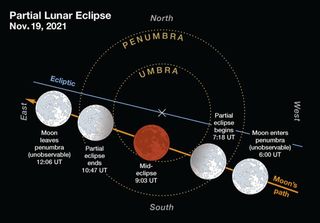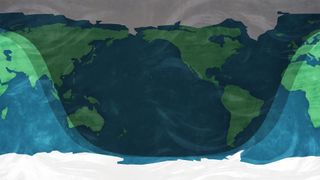Beaver Moon lunar eclipse 2021: When, where and how to see it on Nov. 19
This will be the longest partial lunar eclipse in nearly 600 years.
On Nov. 19, a partial lunar eclipse will reward patient sky observers with a view of a subtly changing moon and is a must-see event as it's the last lunar eclipse of the year. The moon may even take on a reddish hue.
Lunar eclipses occur when the moon passes into the Earth's shadow. In this case, the partial eclipse phase will last 3 hours, 28 minutes and 24 seconds, and the full eclipse for 6 hours and 1 minute, making it the longest partial eclipse in 580 years, according to Indiana's Holcomb Observatory.
At maximum eclipse, the moon's face will be 97% covered by the deepest part of the Earth's shadow and will probably turn a deep red, the observatory said. November's full moon is traditional known as the Beaver Moon, as beavers are preparing for winter, hence this month's event's Beaver Moon eclipse moniker.
You can prepare for the partial lunar eclipse of 2021 with our guide on how to photograph a lunar eclipse, as well as how to photograph the moon with a camera in general, can help you make the most of the event. If you need imaging gear, consider our best cameras for astrophotography and best lenses for astrophotography to make sure you're ready for the next eclipse.
Related: How lunar eclipses work (infographic)
- What time is the Beaver Moon lunar eclipse?
- How to watch the Beaver Moon eclipse online
- Beaver Moon lunar eclipse 2021: When and how to see it on Nov. 19
LONGEST PARTIAL ECLIPSE of the CENTURY to occur in the Pre-dawn hours of November 19th. Maximum eclipse is at 4:03 AM EST when 97% of the Moon will be eclipsed. At that time it will be high in our western sky. This will also be the longest partial lunar eclipse in 580 years! pic.twitter.com/Xa9ciXLp3VNovember 7, 2021
Visibility will be excellent across the Americas, much of Asia and parts of Europe and west Africa, and with the long event time you'll have maximum opportunity to dodge clouds or crowded schedules to see the event unfold.
"Partial lunar eclipses might not be quite as spectacular as total lunar eclipses – where the moon is completely covered in Earth's shadow – but they occur more frequently," NASA said in a description of the eclipse. "And that just means more opportunities to witness little changes in our solar system that sometimes occur right before our eyes."
Get the Space.com Newsletter
Breaking space news, the latest updates on rocket launches, skywatching events and more!
Here are some tips to help you get the most out of the Nov. 19 eclipse.
What time is the lunar eclipse and how long is it?
Lunar eclipses are long events. This one will last about six hours and will peak at 4:02 a.m. EST (0902 GMT). The event will be visible from North and South America, Australia, and parts of Europe and Asia.
The eclipse will take place in four main phases, according to NASA. At 1:02 a.m. EST (0602 GMT) the moon will enter the penumbra, or the lighter part of the moon's shadow. This phase is usually hard to spot without special equipment because the darkening is so slight.
The moon will then arrive at the umbra, or the darker part of the shadow, at 2:18 a.m. EST (0718 GMT). Here you will get to enjoy about 3.5 hours of the moon passing through the deep shadow until it exits the umbra at 5:47 a.m. (1047 GMT). The eclipse will end at 6:03 a.m. EST (1203 GMT).
| Event | Time |
|---|---|
| Penumbral eclipse begins | 1:02 a.m. EST (0602 GMT) |
| Partial eclipse begins | 2:18 a.m. EST (0718 GMT) |
| Maximum eclipse | 4:02 a.m. EST (0902 GMT) |
| Partial eclipse ends | 5:47 a.m. EST (1047 GMT) |
| Penumbral eclipse ends | 7:03 a.m. EST (1203 GMT) |
What will the lunar eclipse look like?

Assuming you can see the entire eclipse, the moon will have different appearances at different stages of the event. While it is in the penumbra or lighter part of the Earth's shadow, it may be difficult for you to see anything at all, especially if you live in a light-polluted region. But as the moon moves closer to the umbra or deep shadow, it will begin to darken, turning a bit greyer than usual.
As the moon approaches the deepest part of the eclipse, the moon will likely turn a dark red or a brown region as it will be 97% eclipsed at the peak. The moon won't be covered all the way, though, as at the point of greatest eclipse there will still be a region near the bottom of the moon (or top of the moon, if you are viewing through many kinds of telescopes) that is in full sunlight.
Where is the 2021 lunar eclipse visible from?

Depending on where you are located, you may not be able to see all of the eclipse. The entire sequence is visible for most of North and Central America, along with the far east of Asia, although extreme eastern regions of the Americas may only be able to view the eclipse before the moon exits the umbral phase.
South America will see most of the eclipse before moonset. Europe and western Africa will see some of the beginning of the eclipse, and central Asia along with the southern Pacific and Australia will see some of the eclipse around moonrise. You can find more details about your region at the NASA website.
Viewing tips for the lunar eclipse
A lunar eclipse requires no special equipment to view. Unlike a solar eclipse, a lunar eclipse is perfectly safe to look at with your eyes. If you want to get a closer look at the "bite" the Earth is taking out of the moon, you can use binoculars or a small telescope. A telescope, especially, will allow you to look at craters on the moon.
Given that November is a cold time of year in more northern regions, make sure to dress warmly. Bring any equipment outside at least half an hour before you expect to use it, to avoid any condensation problems. Make sure that all batteries are well-charged. We highly recommended extra battery packs if you are in an especially frigid region, as the cold will drain your equipment capacity quickly.
Also make sure to let your eyes adjust to the darkness, which will take at least 20 to 30 minutes. The moon is such a bright target that light pollution will likely not be a problem, but if you want to look at other objects, stay as far away from sources of light as possible. If you must use a phone or a flashlight to consult a star map, for example, make sure to use a red filter to protect your night vision.
While you're outside, you can always look at other celestial events. Venus, Jupiter and Saturn are highly visible in the night sky right now, and if you stay out long enough, you'll see Mars rise in the morning. The Leonids will peak on Thursday (Nov, 18) and will still be visible, although the full moon will wash out most meteors during brighter phases of the eclipse.
Editor's Note: If you snap an amazing lunar eclipse photo and would like to share it with Space.com's readers, send your photo(s), comments, and your name and location to spacephotos@space.com.
Follow Elizabeth Howell on Twitter @howellspace. Follow us on Twitter @Spacedotcom and on Facebook.
Join our Space Forums to keep talking space on the latest missions, night sky and more! And if you have a news tip, correction or comment, let us know at: community@space.com.

Elizabeth Howell (she/her), Ph.D., is a staff writer in the spaceflight channel since 2022 covering diversity, education and gaming as well. She was contributing writer for Space.com for 10 years before joining full-time. Elizabeth's reporting includes multiple exclusives with the White House and Office of the Vice-President of the United States, an exclusive conversation with aspiring space tourist (and NSYNC bassist) Lance Bass, speaking several times with the International Space Station, witnessing five human spaceflight launches on two continents, flying parabolic, working inside a spacesuit, and participating in a simulated Mars mission. Her latest book, "Why Am I Taller?", is co-written with astronaut Dave Williams. Elizabeth holds a Ph.D. and M.Sc. in Space Studies from the University of North Dakota, a Bachelor of Journalism from Canada's Carleton University and a Bachelor of History from Canada's Athabasca University. Elizabeth is also a post-secondary instructor in communications and science at several institutions since 2015; her experience includes developing and teaching an astronomy course at Canada's Algonquin College (with Indigenous content as well) to more than 1,000 students since 2020. Elizabeth first got interested in space after watching the movie Apollo 13 in 1996, and still wants to be an astronaut someday. Mastodon: https://qoto.org/@howellspace
